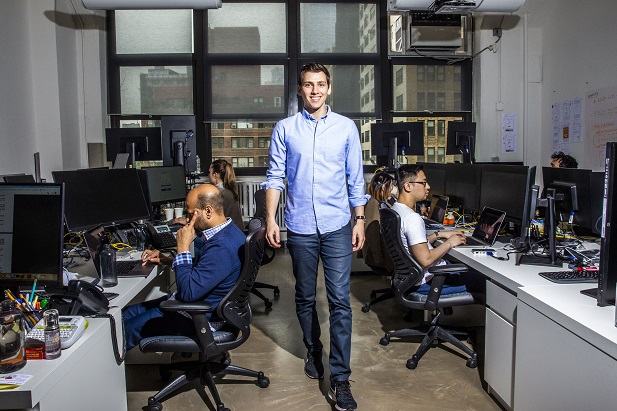 Aaron Shapiro'sfirm cleared a regulatory hurdle in December, when the IRSdetermined that companies can let employees benefit from CarverEdison's loans without jeopardizing the tax-exempt status of theirESPPs. (Photo: Bloomberg)
Aaron Shapiro'sfirm cleared a regulatory hurdle in December, when the IRSdetermined that companies can let employees benefit from CarverEdison's loans without jeopardizing the tax-exempt status of theirESPPs. (Photo: Bloomberg)
(Bloomberg) –Aaron Shapiro's quest to rethink employee stockpurchase plans began with a startling insight: If only his motherhad participated in one, she'd be a millionaire today.
|A few years ago, she asked her son for financial advice andmentioned her employer's ESPP, which she didn't understand. SoShapiro, 26, who got his finance degree from Babson College, duginto the prospectus.
|The employer, UnitedHealth Group Inc., allows workers to buyshares twice a year at a 15 percent discount. There's no minimumholding period, meaning participants can sell the sharesimmediately and pocket the difference.
|“It's arbitrage in its purest form,” Shapiro said. “The moneywas just sitting there and could have been hers, if she'd just beenable to afford payroll deductions.”
|Shares of UnitedHealth have returned almost 4,000 percent in thepast two decades, meaning his mother missed out on gains of morethan $1 million.
|Eureka moment
Shapiro's eureka moment prompted him to found Carver Edison, afintech startup that provides interest-free loans to workers unableset aside money from their paychecks to buy stock on the cheap.
|The firm cleared a major regulatory hurdle in December, when theInternal Revenue Service determined that companies can letemployees benefit from Carver's loans without jeopardizing thetax-exempt status of their ESPPs.
|Eli Broverman, co-founder of robo-adviser Betterment LLC, ledCarver's latest funding round and is a member of its board.
|Now Shapiro is seeking to persuade some of the roughly 4,000U.S. companies that offer ESPPs to millions of workers to useCarver's services and boost participation in the plans.
|Carver's business model hinges on a little financial gymnasticsthat involves capturing a portion of an employee's stock gainsabove a certain threshold and using that to sell options contractsto banks. In any scenario, Shapiro said, the worker will end upbetter off with one of Carver's loans than without it.
|Among his supporters is human-resources consulting firm Aon Plc,which struck a deal with Carver this year to present the concept tocorporate clients.
|Proponents of ESPPs hail them as a lucrative workplace perk thatfosters a culture of ownership among employees and aligns theirinterests with those of shareholders.
|They're also seen as a tool to help curb growing incomeinequality in the U.S. While real wages have largely remainedstagnant for decades, long-term investments in equities have paidoff handsomely, with the S&P 500 generating a total return ofabout 220 percent over the past 20 years.
|Instant disposals
Workers who opt into ESPPs agree to set aside part of everypaycheck to buy company shares on preset dates, usually every threeor six months.
|The shares are bought at a discount of as much as 15 percent tothe market price at the start or end of each period, whichever islower. Some companies require workers to hold the shares for acertain period of time, but most allow instant disposals, accordingto a survey by Fidelity and Radford, a unit of Aon.
|Still, only about one-third of eligible workers actuallyparticipate, said Corey Rosen, who founded the nonprofit NationalCenter for Employee Ownership and briefly served on Carver'sadvisory committee.
|“It's nuts,” Rosen said of the low participation rate. “You'reguaranteed a return except for in very rare circumstances. And youcould end up doing quite well.”
|Some workers may opt out because they don't understand theplans, like Shapiro's mother, or prefer being paid upfront ratherthan deferring it for a future benefit.
|But the biggest barrier is that many simply can't afford to setaside the money, according to Jon Burg, the practice leader ofAon's equity compensation advisory group.
|Two inventors
This group of financially strapped Americans is central toCarver's business model: Offering an opportunity to increase gainsby using leverage, but without downside risk.
|Shapiro said that concept and the company's name is a nod to twoinventors: George Washington Carver, who helped poor farmersimprove agricultural output; and Thomas Edison, who shared some ofhis intellectual property with other scientists for free.
|Here's how it works: An employee at a manufacturing companymaking $34,000 a year is allowed to contribute as much as 10percent of each paycheck over six months to buy stock at a 15percent discount at the end of that period. She can only afford toset aside 5 percent of her pay — or $1,700 — and elects to use aCarver Edison loan for the rest.
|The manufacturing company's stock price was $100 on the firstday of the six-month period and $140 on the final day. The 15percent discount is applied to the lower of the two.
|So on the final day, the worker's $1,700 in deferrals plus anequal-size loan from Carver will be enough to purchase 40 sharesfor $85 apiece. That's an instant 65 percent gain.
|Carver will then immediately sell enough of those shares tocover the loan. In cases when the stock price increase over thesix-month period exceeds a certain threshold — say 25 percent, or$125 in the example above — Carver will collect and sell a fewextra shares.
|Some of those may be sold in the open market, while others willbe sold to banks via options, allowing Carver to generate revenueby collecting a small fee on each contract.
|The idea behind using part of the gains to sell options is “tohave the market makers pay the bills for factory-floor workers tohave more money in their pockets,” Shapiro said.
|Downside protection
In the end, the manufacturing worker will end up with 26.4shares, worth about $3,700, that are hers to keep or sell.
|Had she elected to forgo a Carver loan, she would have been leftwith 20 shares worth $2,800. (Contributions to ESPP stock purchasesaren't tax-deductible, but the example excludes income taxes forsimplicity.)
|Because the shares are bought at a discount, Carver Edison has abuilt-in cushion in case of a sudden drop in the stock.
|To protect itself against a crash, Carver sells the shareswithin seconds of their being delivered by the company and itassumes the balance sheet risk should the stock price crash or atrading glitch occurs during that short window.
|In theory, Carver's model may seem like a no-brainer. But thefirm will still have to figure out how to get people to understandand buy into its concept, which adds another layer of complexity toa topic that many companies already struggle to explain to workers,said NCEO's Rosen.
|“Whether this specific idea will be the one that gets past thesebarriers, I don't know,” he said.
|Shareholder dilution
Shapiro said he's convinced it's possible. Carver will provideeducational material to clients to boost sign-ups among workers aspart of its offering.
|Greater participation will also increase shareholder dilutionand result in higher compensation costs, which could be a deterrentfor some companies, according to Aon's Burg.
|Still, the program brings accounting benefits, and “myexperience is that most companies with an ESPP want higherparticipation and believe in the benefits derived from theprogram,” he said.
|Aon has already seen interest among some clients in Carver'soffering and expects “a handful of early adopters in late 2019,” hesaid. As companies grow more familiar with the concept, “we willsee a wave of quick followers.
|Copyright 2019 Bloomberg. All rightsreserved. This material may not be published, broadcast, rewritten,or redistributed.
Complete your profile to continue reading and get FREE access to BenefitsPRO, part of your ALM digital membership.
Your access to unlimited BenefitsPRO content isn’t changing.
Once you are an ALM digital member, you’ll receive:
- Critical BenefitsPRO information including cutting edge post-reform success strategies, access to educational webcasts and videos, resources from industry leaders, and informative Newsletters.
- Exclusive discounts on ALM, BenefitsPRO magazine and BenefitsPRO.com events
- Access to other award-winning ALM websites including ThinkAdvisor.com and Law.com
Already have an account? Sign In
© 2024 ALM Global, LLC, All Rights Reserved. Request academic re-use from www.copyright.com. All other uses, submit a request to [email protected]. For more information visit Asset & Logo Licensing.








